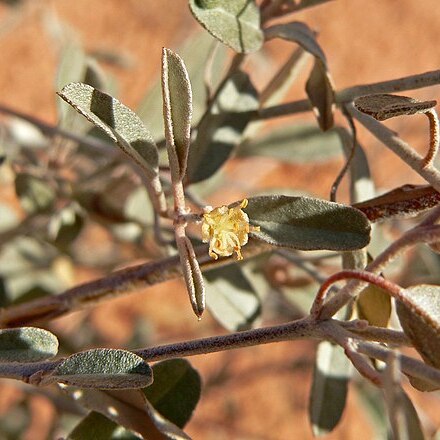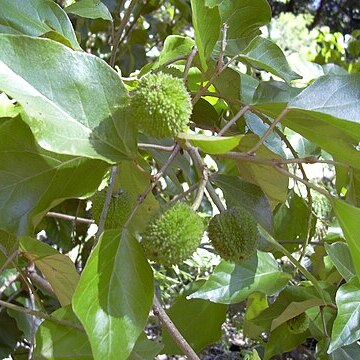Herbs, subshrubs, or shrubs [trees], annual or perennial, monoecious or dioecious; hairs stellate or scalelike; latex colorless to reddish [absent]. Leaves persistent, semideciduous, or drought deciduous, alternate, simple, often with lemony, pungent, or acrid odor when crushed, older leaves often turning orange before falling; stipules absent or present, persistent, deciduous, or caducous; petiole present [absent], glands present at apex or absent; blade unlobed [palmately lobed], margins entire, crenate, denticulate, serrulate, or serrate-dentate, laminar glands absent [at base, on margins or abaxial surface]; venation pinnate or palmate at base, pinnate distally. Inflorescences unisexual or bisexual (pistillate flowers proximal, staminate distal), terminal or axillary, spikes, racemes, or thyrses; glands subtending each bract 0. Pedicels present or absent. Staminate flowers: sepals (3–)5(–6), valvate or slightly imbricate, distinct or connate basally; petals (3–)5(–6) or 0, distinct, white; nectary extrastaminal, usually 5 glands; stamens 3–35[–50], inflexed in bud, distinct; pistillode absent. Pistillate flowers: sepals [3–](4–)5(–9)[–10] or 0, imbricate or valvate, distinct (connate for 1/2+ length in C. argyranthemus); petals 5 (sometimes rudimentary) or 0, distinct or connate basally, white or pale green; nectary annular, 5 glands, or absent; pistil (1–)3-carpellate; styles (1–)3, distinct or connate basally, unbranched, 2-fid, or multifid. Fruits usually capsules (achenes in C. michauxii). Seeds ellipsoid, oblong, ovoid, globose, or lenticular; caruncle present. x = 8, 9, 10, 14.
Herbs, lianes, shrubs or small trees, annual or perennial, monoecious or dioecious, evergreen or deciduous; stems and foliage without latex. Indumentum of simple or compound trichomes and scales in various combinations, glandular trichomes absent, stinging trichomes absent. Stipules entire or lobed, generally inconspicuous, deciduous. Leaves alternate to subopposite, sessile to petiolate, simple and usually elobate, entire or denticulate to crenate, palmi-or penninerved, often with sessile or stipitate glands at lamina base or on petiole. Inflorescences terminal or axillary, racemose or spicate, solitary, uni-or bisexual and androgynous, with flowers in bracteate glomerules. Male flowers sessile or pedicellate; calyx lobes 4–6, imbricate or valvate, ± equal; petals 4–6, free; stamens 5–50, filaments free and attached to a slightly raised pilose receptacle, inflexed in bud, filiform or flattened; anthers dorsifixed, bilobate, thecae oblong and longitudinally dehiscent; pistillodes absent. Female flowers sessile to pedicellate; calyx lobes 4–6, imbricate or valvate; petals usually absent; disc annular, or of separate glands or absent; ovary 1–3-(or 4)-locular, ovules uniloculate; styles shortly connate at base, bifid to multifid [entire in C. setigerus]. Fruit capsular, uni-, bi-or trilobate, surface smooth and variously pubescent, dehiscing septicidally into bivalved cocci. Seeds ovoid, obloid, ellipsoid or subglobose; testa crustaceous to woody; albumen fleshy; caruncles entire, non-arilloid; cotyledons broad, flat.
Trees or shrubs, rarely subshrubs, monoecious or more rarely dioecious; latex clear or reddish, often scanty or apparently absent; indumentum of stellate hairs and/or peltate scales. Leaves alternate, rarely opposite or nearly verticillate; stipules present or absent; petiole with or without apical paired glands; leaf blade simple, margin entire or denticulate, often with glands; venation pinnate or palmate. Inflorescences terminal or axillary, racemelike thyrses, often with proximal solitary female flowers and distal male flowers, often in clusters. Male flowers: sepals mostly 5, imbricate to valvate, free; petals 5, smaller or nearly equal to sepals; disk glandular, usually 5, and opposite sepals; stamens 10-20; filaments free, inflexed in bud; anthers muticous; pistillode absent. Female flowers: sepals 5, often narrower than in male, imbricate to reduplicate-valvate, persistent, sometimes accrescent; petals 5, smaller than in male, mostly reduced or obsolete; disk annular or dissected, receptacle often villous; ovary 3-locular; ovules 1 per locule; styles 3, longer and slender, free or nearly so, once to several times bifid. Fruit a capsule dehiscing into 3 2-valved cocci, more rarely ± indehiscent and fleshy, drupelike or berrylike. Seeds usually smooth, carunculate; testa crustaceous; endosperm copious, fleshy; cotyledon broad and flattened.
Trees, shrubs, or herbs; monoecious or dioecious; stems usually with colored sap, the indumentum (at least in part) stellate or lepidote. Leaves alternate; petiolate (petioles often with glands near the top); stipulate (stipules sometimes obscure or obsolete); blades pinnately or palmately veined, sometimes lobed, entire or serrate. Inflorescences spicate-racemose (or sometimes paniculate or subcapitate), terminal or axillary; bisexual racemes mostly with 9 flowers solitary at proximal nodes, male 1-several at distal nodes (sometimes at same nodes with female). Staminate flowers with 4-6 imbricate or (most often) valvate calyx-lobes; disc entire or dis-sected; petals usually 5 (rarely absent); stamens mostly 8-50, free, the filaments inflexed in bud; pollen grains globose, inaperturate, clavate; pistillode absent. Pistillate flowers with 4-10 (mostly 5-7) imbricate or valvate calyx-lobes; disc usually entire, rarely dissected, sometimes with staminodia; petals 5, often reduced or absent; ovary of 3 (rarely 2) carpels, the ovules 1 per locule; the styles more or less free, once to repeatedly bifid or bipartite. Fruits capsular; seeds terete to compressed, dry, carunculate, endosperm present, the embryo with broad cotyledons.
Monoecious or dioecious; cal 5–7-lobed; pet mostly as many as and about equaling the sep in staminate fls, but reduced or wanting in pistillate fls; stamens (3–)8–20+, inflexed in bud; anthers elongate; disk present; ovary (2)3-locular, with 1 ovule per locule; styles distinct or nearly so, bifid or dissected; fr capsular; seeds (1–)3, carunculate; herbs, shrubs, or trees with stellate pubescence, the small fls borne chiefly in condensed, spike-like, terminal infls. 600+, cosmop.In addition to the following spp., the southwestern sp. C. lindheimerianus Scheele has been reported from Ill. It is a diffusely branched, monoecious annual with entire lvs and 3 styles, each bifid to the base.
Female flowers pedicellate; sepals generally persistent, slightly accrescent, equal or unequal; petals often smaller than in male flowers, sometimes replaced by tufts of hairs or absent; staminodes sometimes present; disk annular, or of separate glands, or vestigial; ovary 2(3)4-locular, with 1 ovule per loculus; styles 1–several times bifid or bipartite, or multifid or multipartite.
Male flowers shortly pedicellate; buds subglobose; sepals (4)5(6), valvate or imbricate, ± equal; petals (4)5(6), free; disk glands opposite the sepals, free or fused, fleshy; stamens 5–many, free, filaments inflexed in bud, later erect, anthers pendulous in bud, later erect, longitudinally dehiscent; receptacle usually pilose; pistillode absent.
Leaves alternate, sometimes subopposite or ± whorled, stipulate, petiolate, with 2 or more sessile or stipitate discoid glands at the petiole apex or the lamina base, simple, entire, toothed or lobed, penninerved or palminerved.
Fruits septicidally dehiscent into 3 bivalved cocci, loculicidally dehiscent into 3 valves, irregularly frangent (breaking up) or drupaceous and indehiscent; endocarp woody or crustaceous.
Monoecious or sometimes dioecious trees or shrubs (or herbs or lianes outside the Flora Zambesiaca area) with a stellate and/or lepidote indumentum.
Seeds carunculate; testa woody or crustaceous; albumen fleshy, copious; embryo straight; cotyledons broad and flat.
Inflorescences usually terminal, racemose, androgynous or unisexual; bracts small.


